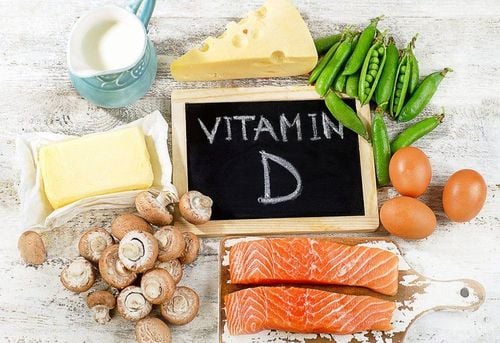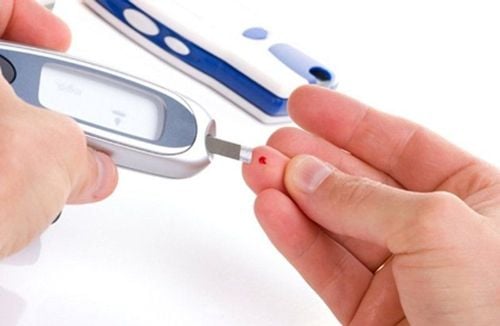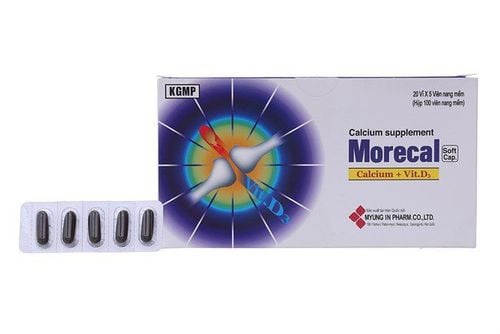This is an automatically translated article.
Vitamin D is an important nutrient that works with calcium to help form bones and keep children's bones strong. Vitamin D plays a role in preventing health problems such as metabolic cardiovascular disease, diabetes, osteoporosis and thinning of the bones.
Our body naturally produces vitamin D when we are out in the sun. So many children get enough vitamin D naturally when they engage in daily activity, such as walking, biking or playing sports. But sometimes a child's body doesn't make enough vitamin D and it can be difficult to get enough of this nutrient from a child's diet because few foods naturally contain vitamin D. So how should vitamin D be added to the child's diet?
1. Vitamin D in your child's diet
1.1. Importance of vitamin D Vitamin D is important for the growth and health of young children. Vitamin D is an essential nutrient that helps the body absorb calcium and phosphate from food, which are important for children to have healthy bones and help control blood calcium levels. According to researcher Michael F. Holick, professor of medicine, physiology, and biophysics at Boston University School of Medicine, vitamin D deficiency can not only cause rickets (a disease that can lead to deformity). bones and fractures) but also can cause children to break bones, even prevent the height growth regulated by genetics and develop the maximum skeletal system in children. Some recent studies also suggest that Vitamin D can also prevent some other diseases for children such as bowel cancer, heart disease, high blood pressure, stroke, and reduce the risk of allergies for children.
Vitamin D is well known for its role in bone development, in addition they play a role in building the immune system to protect your child as they grow, producing insulin and protecting them. from infections.

Vitamin D có thể ngăn ngừa một số bệnh khác cho trẻ như bệnh tim
1.2. Children at risk of vitamin D deficiency Pediatric experts have given some signs to identify children at risk of vitamin D deficiency as follows:
Children have dark skin. Children get little exposure to the sun, for example, they wear a lot of clothes or just stay indoors. Premature infants Breastfed infants have one or more of the above risk factors. Because breast milk, although best for the development of infants, contains little vitamin D, babies will receive their initial store of vitamin D through breast milk. If a mother has a vitamin D deficiency, her baby will also have low levels of vitamin D. Children have a number of diseases that affect the absorption and control of vitamin D by the body such as liver disease, kidney disease, cystic fibrosis, inflammatory bowel disease... Children using certain drugs such as epilepsy. 1.3. Signs and Symptoms of Vitamin D Deficiency Many people have low levels of vitamin D but have no symptoms, while some children with low levels of vitamin D develop growth retardation rickets and osteomalacia. in adolescents and adults. The phenomenon of rickets only occurs in growing children, due to vitamin D deficiency, children's bones will be softer, causing bones to bend and lead to "bow legs".
Vitamin D deficiency can cause low calcium levels, leading to muscle fatigue in children of all ages, and even seizures and cardiomyopathy in infants.

Trẻ sinh non có nguy cơ thiếu vitamin D
1.4. The amount of vitamin D babies need Pediatric nutritionists have made recommendations for the amount of vitamin D children need as follows:
Infants up to 12 months of age need 400 international units (IU), or 10 micrograms (mcg). ) everyday. Children over 1 year of age need 600 IU, or 15 mcg/day. According to the Division of Supplements Administration (a division of the US National Institutes of Health), the safe upper limit for infants under 12 months of age is 1,000 to 1,500 IU per day. For children 1 to 8 years old, the safe upper limit is 2,500 to 3,000 IU per day. Vitamin D is stored in body tissues, experts recommend not to take too much vitamin D, so consult your doctor before giving it to your child.
Children do not necessarily need vitamin D supplements every day. Instead, set a goal of giving your child vitamin D every few days or weeks.
1.5. Sources of Vitamin D Vitamin D is known as the "sunshine vitamin" because the body can produce it when the skin is exposed to sunlight. But a child's body will not be able to make vitamin D when wearing too many clothes and applying sunscreen because they prevent the sun's exposure to the baby's skin. Other obstacles that prevent vitamin D absorption from the sun include dew, clouds, dark skin, and geographic location.
It is difficult to estimate how long a person needs to be exposed to the sun to get enough vitamin D, some researchers recommend that you spend 5–30 minutes outside in the sun. from 10 a.m. to 3 p.m. at least twice a week to absorb vitamin D. But that was previously thought, and now research has shown that the sun's rays needed for vitamin D synthesis are ultraviolet B rays. (UBV), this light is usually present in the early morning or afternoon, but then the atmosphere blocks ultraviolet rays, so the body cannot synthesize vitamin D. The duration of sun exposure should be based on the signs on the skin of the person. children stop when they see their skin pink or tanned.

Sử dụng các chế phẩm bổ sung vitamin D cần thiết nếu thiếu có thể làm tăng nguy cơ ung thư da
It is important to know that ultraviolet radiation from the sun is the main cause of skin cancer, and it is not easy to judge whether a child has received the necessary amount of vitamin D without increases the risk of skin cancer. Therefore, you should consider adding vitamin D to your child in another way, such as using vitamin D supplements or increasing the use of foods rich in vitamin D. The American Academy of Pediatrics recommends that all infants, children, and adolescents get 400 IU of vitamin D per day. Children who are too young to chew vitamins can take liquid supplements.
Some foods high in vitamin D:
30g salmon contains 102 IU 180g fortified yogurt contains 80 IU 30g tuna canned drained or packed in oil contains 66 IU 60 ml fortified orange juice with 25% daily value for vitamin D contains 50 IU 60 ml fortified milk (whole, low fat or skim) contains 49 IU 60g fortified instant cereal contains 19 IU 30g mackerel contains 11.6 IU 1/2 yolk large eggs contain 10 IU 1/2 teaspoon of margarine contains 10 IU. The amount of vitamin D in foods varies, so it depends on the size of the fruits and vegetables. Depending on the needs and taste of the child, you choose the food and nutritional balance for the child.
2. Taking care of children with vitamin D deficiency

Trẻ em có lượng vitamin D trong cơ thể thấp hãy cho trẻ uống 1-2 ly sữa mỗi ngày
Take your child to the GP if he or she has any symptoms of low vitamin D or low calcium (as noted above). Children at risk for vitamin D deficiency should have a blood test 3 months after starting the supplement, to check their vitamin D levels. Use vitamin D supplements for children and encourage them to be outdoors more.
Children with low vitamin D levels also need calcium in their diets by encouraging them to drink 1-2 glasses of milk a day or use yogurt or cheese. If your child has a seizure that lasts less than 5 minutes, get him or her to the nearest emergency room as soon as the seizure ends. If the seizure lasts more than five minutes, call an ambulance.
Children in the period from 6 months to 3 years old are very susceptible to respiratory problems, respiratory infections, skin diseases and gastrointestinal infections... parents need special attention attention to the care and provision of adequate nutrition for children. It is necessary to add lysine, essential micro-minerals and vitamins such as zinc, chromium, selenium, B vitamins under the advice of a specialist.
For more nutritional knowledge and child care for each age, parents should regularly visit the website vimec.com and make an appointment with the leading doctors, pediatric and nutrition experts of the National General Hospital. Vinmec when needing advice on children's health.
References: babycenter.com, rch.org.au
Recommended video:
Which food is Vitamin D in?
SEE MORE
Vitamin D: Uses, dosage, side effects Vitamin D rich foods Have you added enough vitamin D?













